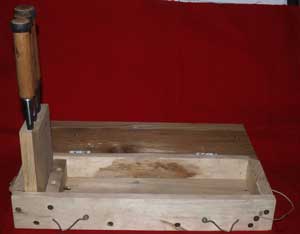 Good chisels deserve good storage. If you regularly set a chisel down unprotected on the bench top, it could easily be nicked several times a day. Each time it gets nicked, it must be resharpened, which takes valuable time. Not only does resharpening take time, but good chisels are expensive, and every nick in the edge could cost you 50 cents. Aside from the hazard to the chisel, an exposed chisel edge also presents a serious hazard to hands and fingers. Obviously, making a chisel rack is time well-spent. Not only does it keep the chisel and your fingers safe, it dramatically reduces the time you spend hunting around for the chisel you need.
Good chisels deserve good storage. If you regularly set a chisel down unprotected on the bench top, it could easily be nicked several times a day. Each time it gets nicked, it must be resharpened, which takes valuable time. Not only does resharpening take time, but good chisels are expensive, and every nick in the edge could cost you 50 cents. Aside from the hazard to the chisel, an exposed chisel edge also presents a serious hazard to hands and fingers. Obviously, making a chisel rack is time well-spent. Not only does it keep the chisel and your fingers safe, it dramatically reduces the time you spend hunting around for the chisel you need.
Design
Many chisel racks use a rigid design that holds the chisels upright all the time. That design 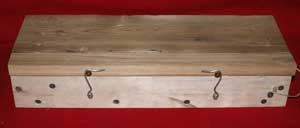 protects the blade well and makes it easy to grab a chisel when you need it, but it uses a lot of space. Another common storage method is to keep the chisels flat in a box. This is more compact and provides protection to the chisel handle, but when the box is open it leaves the blades less protected than the upright design. I wanted something that combined the best features of both designs, so I built a folding rack that stands up when I need it and folds into a box when I am done. It gives the chisels and my fingers maximum protection, is small enough to fit in my limited space, and enables me to quickly grab a chisel when I need it.
protects the blade well and makes it easy to grab a chisel when you need it, but it uses a lot of space. Another common storage method is to keep the chisels flat in a box. This is more compact and provides protection to the chisel handle, but when the box is open it leaves the blades less protected than the upright design. I wanted something that combined the best features of both designs, so I built a folding rack that stands up when I need it and folds into a box when I am done. It gives the chisels and my fingers maximum protection, is small enough to fit in my limited space, and enables me to quickly grab a chisel when I need it.
Make the Rack
The part that holds the chisels is the same as the upright part of a rigid rack. The most important feature of this piece is that the chisel should not touch the bottom of the slot. In most shops, grit will accumulate in the bottom of the slot and nick the chisel edge if it is allowed to touch it. 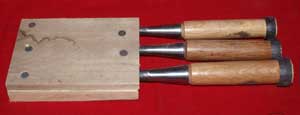 Most chisels get thinner towards the end, so this is easily accomplished by making the slot longer than the flat part of the chisel. Find a 3/4″ thick board, cut it to 1-1/4” longer than your chisel slots, and mark the places for the chisel slots on the face. Leave 1/4” between slots and 3/8” between slots and the edge of the board. Use the chisel to stop the cut where the edges and ends of the slots will be. This helps to keep the cut you make from bringing splinters with it from outside the desired area. Slowly cut down until the slots are as deep as the thinnest part of the chisel. If the flat part of the chisel is tapered, cut the slot to match. When you have all three slots right, cut a 1/4” thick piece of wood to the same size as the board and screw it on the face with the slots. We now have what looks like the upright part of a normal chisel rack, and we need to make a box for it.
Most chisels get thinner towards the end, so this is easily accomplished by making the slot longer than the flat part of the chisel. Find a 3/4″ thick board, cut it to 1-1/4” longer than your chisel slots, and mark the places for the chisel slots on the face. Leave 1/4” between slots and 3/8” between slots and the edge of the board. Use the chisel to stop the cut where the edges and ends of the slots will be. This helps to keep the cut you make from bringing splinters with it from outside the desired area. Slowly cut down until the slots are as deep as the thinnest part of the chisel. If the flat part of the chisel is tapered, cut the slot to match. When you have all three slots right, cut a 1/4” thick piece of wood to the same size as the board and screw it on the face with the slots. We now have what looks like the upright part of a normal chisel rack, and we need to make a box for it.
Make the Box
Find a board the same width as the chisel holder. Measure the length of the chisel holder with chisels in it and add 3-3/4″. Cut the board to this length. Now cut two 2” wide boards to this same length and screw them to the sides of the first one. Cut two small pieces of wood as wide as the 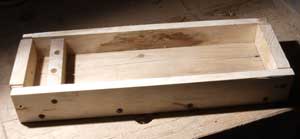 chisel rack and 2” long. These will be dovetailed into the ends of the board to keep it from splitting. You can dovetail them to the sides as well or just use screws. The next step is to add a way for the chisel rack to stand up and fold down. I considered using a hinge, but I did not have a suitable one on hand. Instead, I put a slot at one end that holds the chisel holder upright. It is locked in place with a pin. Cut a piece of
chisel rack and 2” long. These will be dovetailed into the ends of the board to keep it from splitting. You can dovetail them to the sides as well or just use screws. The next step is to add a way for the chisel rack to stand up and fold down. I considered using a hinge, but I did not have a suitable one on hand. Instead, I put a slot at one end that holds the chisel holder upright. It is locked in place with a pin. Cut a piece of 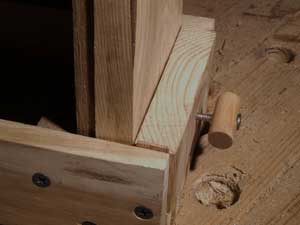 wood as wide as the chisel holder is thick and 1-1/4” long. Stand the chisel holder up against the end of the box, push the block of wood against it and mark where it goes. Take out the block, pre-drill screw holes, and screw it in place. Mark a location for the pin on the end of the box where it will not hit any screws. Because the chisel holder is 1-1/4” longer than the slots, it is impossible to hit a slot. When you have found the right location, drill a hole for the pin. I used an ordinary 16 penny nail and a 9/64″hole. Although the nominal size of the nail was .131, there were burrs near the point that needed to be removed before it would fit. Unless you possess a set of hole-shrinking drill bits, you should make enlarging the hole your last resort.
wood as wide as the chisel holder is thick and 1-1/4” long. Stand the chisel holder up against the end of the box, push the block of wood against it and mark where it goes. Take out the block, pre-drill screw holes, and screw it in place. Mark a location for the pin on the end of the box where it will not hit any screws. Because the chisel holder is 1-1/4” longer than the slots, it is impossible to hit a slot. When you have found the right location, drill a hole for the pin. I used an ordinary 16 penny nail and a 9/64″hole. Although the nominal size of the nail was .131, there were burrs near the point that needed to be removed before it would fit. Unless you possess a set of hole-shrinking drill bits, you should make enlarging the hole your last resort.
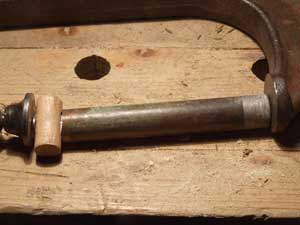 Some kind of knob for the pin is a nice touch. Take a 1” length of 3/8” diameter dowel and cross-drill a 1/8” hole through the middle. This assumes that your nail has a diameter of about .131”. If it is different, use a drill bit that is about .006” smaller than your nail. Since you are cross-drilling a round dowel, It helps to start the hole with a machinist’s combined drill and countersink. Drill in with this until the countersunk area is larger than the drill you will be
Some kind of knob for the pin is a nice touch. Take a 1” length of 3/8” diameter dowel and cross-drill a 1/8” hole through the middle. This assumes that your nail has a diameter of about .131”. If it is different, use a drill bit that is about .006” smaller than your nail. Since you are cross-drilling a round dowel, It helps to start the hole with a machinist’s combined drill and countersink. Drill in with this until the countersunk area is larger than the drill you will be 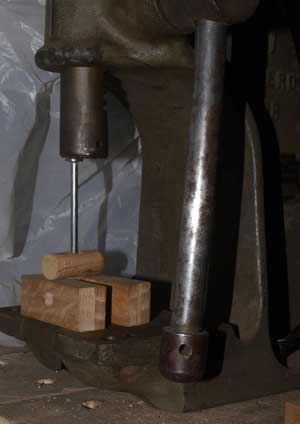 using. This ensures that it will not wander. When the hole is drilled, press the nail through. You can do this with a C clamp and a piece of pipe or with an arbor press.
using. This ensures that it will not wander. When the hole is drilled, press the nail through. You can do this with a C clamp and a piece of pipe or with an arbor press.
At this point, you could declare the chisel rack complete, but I decided to add a lid. This is a simple matter of a suitably sized board, two hinges, and a latch. My main reason for the lid was that I have limited shelf space. 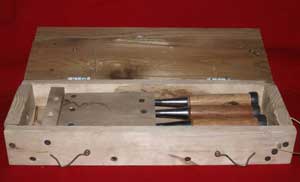 With the addition of a lid to keep the chisels in the box, I could add a hanger and hang the box on a hook. This completes the chisel rack. Now, not only do you have compact protection for your expensive chisels, but you can live by the motto that “The edge is never dull.”
With the addition of a lid to keep the chisels in the box, I could add a hanger and hang the box on a hook. This completes the chisel rack. Now, not only do you have compact protection for your expensive chisels, but you can live by the motto that “The edge is never dull.”






